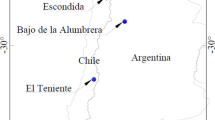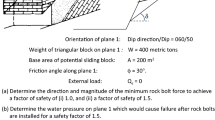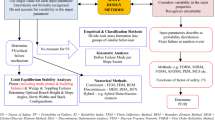Abstract
In Europe, rock slope stability analysis and slope design have to be based on Eurocode 7, which is today the basic standard for geotechnical, including rock engineering, design. According to Eurocode 7, several principles for stability analysis may be applied, including empirical, limit equilibrium, numerical, and probabilistic. Very often, particularly for excavated slopes, the limit equilibrium method is used for stability analysis and design. One particularly significant consequence of the introduction of Eurocode 7 is that for limit equilibrium analysis according to the Eurocode, the traditional principle of calculating a factor of safety cannot be used. Instead, the so-called partial factor principle is to be used. The intention of the Eurocodes seems to be that Reliability Based Design should be applied also in rock engineering. This is, however, not reflected by the guidelines and descriptions of the present (2004)-edition of Eurocode 7, and for this and several other reasons there is considerable confusion and uncertainty related to the use of Eurocode 7 for rock engineering analysis and design. This paper discusses this issue with particular focus on limit equilibrium analysis of rock slope stability. It is concluded that due to the uncertain and variable character of input parameters, the limit equilibrium approach has evident shortcomings for stability analysis of rock slopes, particularly when the partial factor principle is applied.






Similar content being viewed by others
References
Barton N, Bandis S (1990) Review of predictive capabilities of JRC-JCS model in engineering practice. In: Proceedings of International Conference On Rock Joints. AA Balkema, Loen, Norway, pp 603–610
CEN (2002) Eurocode: basis of structural design. European Standard with Norwegian NA, NS-EN 1990:2002 + NA:2008. Standards Norway/Comité Européen de Normalisation, 71 p. + NA
CEN (2004a) Eurocode 7: geotechnical design—part 1: general rules. European Standard with Norwegian NA, NS-EN 1997-1:2004 + NA:2008. Standards Norway/Comité Européen de Normalisation, 139 p. + NA 10 p
CEN (2004b) Eurocode 7: geotechnical design—part 2: ground investigation and testing. European Standard with Norwegian NA, NS-EN 1997-2:2007 + NA:2008. Standards Norway/Comité Européen de Normalisation, 196 p. + NA 2 p
CEN (2013) Eurocode 8: Design of structures for earthquake resistance—part 1 general rules, seismic actions and rules for buildings. European Standard with Norwegian NA, NS-EN 1998-1:2004 + NA:2008. Standards Norway/Comité Européen de Normalisation, 171 p. + NA
DSB (2011) Guidelines for technical regulations according to the planning and construction law,—Chapter 7: safety requirements regarding nature disasters (in Norwegian). Directorate for Public Protection (DSB), Oslo
Grøneng G, Nilsen B (2009a) Procedure for determining input parameters for Barton-Bandis joint shear strength formulation. Report No. 38, NTNU, Department of Geology and Mineral Resources Engineering
Grøneng G, Nilsen B (2009b) Shear strength estimation for Åknes sliding area in western Norway. Int J Rock Mech Min Sci 46:479–488
Harrison J (2015) History and basic principles of EC7 and limit state design. In: Proceedings of International Workshop Adopting and Developing Eurocode 7 for Rock Engineering Design, Singapore, 5–6 November 2015
Hoek E, Bray JW (1991) Rock slope engineering, 3rd edn (reprinted). Inst. Min. Met., London, p 358
Low BK (2015) Insights from Reliability-based design to complement EC7. In: Proceedings of International Workshop Adopting and Developing Eurocode 7 for Rock Engineering Design, Singapore, 5–6 November 2015
NBG (2011) Guideline for use of Eurocode 7 in rock engineering design (in Norwegian). NBG report, Norwegian national group of ISRM, p 54
NBR (1988) Norwegian Standard 3480 —geotechnical planning (in Norwegian). Norwegian Council for Building Standardization (NBR), p 11
Nilsen B (2000) Alternative approaches of rock slope stability analysis. Proc. Int. Conf. GeoEng 2000. Melbourne, 19–24 November 2000. Australian Geomechanics Society
NPRA (2014) Road construction. Norwegian Public Roads Administration, Handbook N500, p 528
Wyllie DC, Mah CW (2004) Rock slope engineering, 4th edn. Spon Press, London, New York, p 431
Author information
Authors and Affiliations
Corresponding author
Rights and permissions
About this article
Cite this article
Nilsen, B. Rock slope stability analysis according to Eurocode 7, discussion of some dilemmas with particular focus on limit equilibrium analysis. Bull Eng Geol Environ 76, 1229–1236 (2017). https://doi.org/10.1007/s10064-016-0928-9
Received:
Accepted:
Published:
Issue Date:
DOI: https://doi.org/10.1007/s10064-016-0928-9




